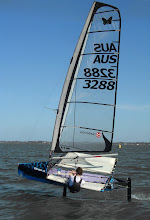With the foam moulds finished for the main hull components, it was time to do the layups and pull parts off. I did the smallest part, the foredeck first to test the process using a few odd-shaped bits of carbon and some 3mm Nomex inside the curved section. It was a bit of a half-assed job and when it came out, it was a little bit heavier than I'd hoped - just under 500g - but in the end I decided it was god enough to use. I did the deck and fairings next, one at a time as the vacuum pump was sounding a bit sick and I didn't want to loose them all at once. Meanwhile I made an effort to track down someone who sold vacuum pump oil.
The fairings were simple to lay up except for the sail track that picks up the lower skin of the tramp. That ended up being a 9mm ID tube that I glued into the monolithic carbon part, and then reinforced a bit more on the inside and cut the groove at the end.
The deck was the last thing to do, and I laid it up with 200g cloth on 6mm foam with some local reinforcing. On Andrew's (CG) advice I used a bit of 75g glass between the foam and the top skin of carbon to trap some extra resin there and ensure a solid bond, as I had some delanination there with my last deck. I carefully cut the recesses for the wingbar sockets out of the foam, not realising they were the wrong way around, an went ahead with the layup and the bag. It all sucked down very well when the vac pump finally choked and died. I think some oil leaked through the shaft seal and into the motor, and started burning on some hot part. I turned off the valve to seal the bag and just waited to see if it was all going to go to waste. Amazingly, the bag and foam mould were completely sealed, and it held a reasonable vacuum until cured. I ended up with a bit more resin in there than I hoped, but the part was usable. If I did it again I could probably save 50-100g, so a bit like the foredeck, I figure I can live with it.
Anyway those four major parts are now ticked off. The deck weighed in at 1.6kg with the fibreglass rods glued into the sides, the fairings / sail tracks ended up being a bit under 1.4kg for the pair. That's a bit of a weight penalty, but it's a trade off - add a bit of weight, subtract a bit of drag. It's hard to know where to go on things like that, but I'm committed to the design so im going with it. I can always cut them off again if the boat's slow.
The fairings were simple to lay up except for the sail track that picks up the lower skin of the tramp. That ended up being a 9mm ID tube that I glued into the monolithic carbon part, and then reinforced a bit more on the inside and cut the groove at the end.
 |
| The foredeck fresh out of the mould |
The deck was the last thing to do, and I laid it up with 200g cloth on 6mm foam with some local reinforcing. On Andrew's (CG) advice I used a bit of 75g glass between the foam and the top skin of carbon to trap some extra resin there and ensure a solid bond, as I had some delanination there with my last deck. I carefully cut the recesses for the wingbar sockets out of the foam, not realising they were the wrong way around, an went ahead with the layup and the bag. It all sucked down very well when the vac pump finally choked and died. I think some oil leaked through the shaft seal and into the motor, and started burning on some hot part. I turned off the valve to seal the bag and just waited to see if it was all going to go to waste. Amazingly, the bag and foam mould were completely sealed, and it held a reasonable vacuum until cured. I ended up with a bit more resin in there than I hoped, but the part was usable. If I did it again I could probably save 50-100g, so a bit like the foredeck, I figure I can live with it.
I went to the cleverly named vacuum pump place 'absolute vacuum' and sorted out some new oil, took the pump apart and cleaned it out, and miraculously it now works like new. It turns out when you let it suck resin and whatever else into the rotor, it stops working. I now have a proper gauge, but am still waiting on a couple of valves and a new 'catch pot' for all the unwanted bits, and then I'll have confidence in the pump again.
 |
| the deck gallantly holding a vacuum |
 |
| The back of the sail track, showing the bit of reinforcing on the inside. |
Anyway those four major parts are now ticked off. The deck weighed in at 1.6kg with the fibreglass rods glued into the sides, the fairings / sail tracks ended up being a bit under 1.4kg for the pair. That's a bit of a weight penalty, but it's a trade off - add a bit of weight, subtract a bit of drag. It's hard to know where to go on things like that, but I'm committed to the design so im going with it. I can always cut them off again if the boat's slow.
The last image is of the four parts post-curing on the roof. It was easily 50 degrees up there so I thought why bother with the oven!










.JPG)



